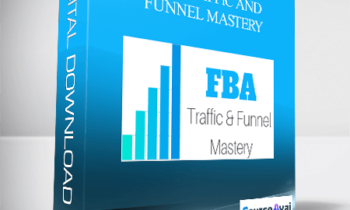-
×
 Hack the Entrepreneur - 1,000 Maniacs: Complete Training Course - Jonny Nastor
1 × $48.00
Hack the Entrepreneur - 1,000 Maniacs: Complete Training Course - Jonny Nastor
1 × $48.00 -
×
 Ryan Rigney - FBA Traffic and Funnel Mastery
1 × $84.00
Ryan Rigney - FBA Traffic and Funnel Mastery
1 × $84.00 -
×
 Jordan Gray GB - How To Find Your Ideal Partner
1 × $9.00
Jordan Gray GB - How To Find Your Ideal Partner
1 × $9.00 -
×
 2-Day Certificate Course: Treating Trauma in Intimate Relationships - Healing the Trauma Legacy in Couples Therapy - Janina Fisher
1 × $124.00
2-Day Certificate Course: Treating Trauma in Intimate Relationships - Healing the Trauma Legacy in Couples Therapy - Janina Fisher
1 × $124.00 -
×
 Make 'Em Laugh & Take Their Money - Dan Kennedy
1 × $17.00
Make 'Em Laugh & Take Their Money - Dan Kennedy
1 × $17.00 -
×
 Disordered Eating Behaviors: Identify and Treat the Underlying Trauma - Lori Kucharski
1 × $85.00
Disordered Eating Behaviors: Identify and Treat the Underlying Trauma - Lori Kucharski
1 × $85.00 -
×
 2-Day: Medical Screening and Differential Diagnosis Intensive Training Course - Shaun Goulbourne
1 × $180.00
2-Day: Medical Screening and Differential Diagnosis Intensive Training Course - Shaun Goulbourne
1 × $180.00 -
×
 8x Hero Academy – Alex Becker
1 × $94.00
8x Hero Academy – Alex Becker
1 × $94.00 -
×
 Spartan Forex Trader Academy – 800k Forex Workshop
1 × $45.00
Spartan Forex Trader Academy – 800k Forex Workshop
1 × $45.00 -
×
 Bob Cenk - Listings Domination Academy
1 × $56.00
Bob Cenk - Listings Domination Academy
1 × $56.00 -
×
 10x Emails Comprehensive – Copy Hackers
1 × $45.00
10x Emails Comprehensive – Copy Hackers
1 × $45.00 -
×
 1 Hour SEO | Become a Technical Marketer
1 × $40.00
1 Hour SEO | Become a Technical Marketer
1 × $40.00
$199.99 Original price was: $199.99.$84.00Current price is: $84.00.
Total Size:
Digital products: Get the download link at Account or directly via email.
Support: Lifetime
Download: Unlimited Of Course Mastering Telehealth and Anxiety Treatment in the Age of Social Distancing: Your guide to documentation, ethics and insurance – Catherine M. Pittman and Joni Gilbertson
 Purchase this course you will earn 84 Points worth of $8.40
Purchase this course you will earn 84 Points worth of $8.40
Category: Uncategorized
Total Size:
Digital products: Get the download link at Account or directly via email.
Support: Lifetime
Download: Unlimited Of Course Mastering Telehealth and Anxiety Treatment in the Age of Social Distancing: Your guide to documentation, ethics and insurance – Catherine M. Pittman and Joni Gilbertson
Purchase Mastering Telehealth and Anxiety Treatment in the Age of Social Distancing: Your guide to documentation, ethics and insurance – Catherine M. Pittman and Joni Gilbertson courses at here with PRICE $199.99 $84
When purchasing Mastering Telehealth and Anxiety Treatment in the Age of Social Distancing: Your guide to documentation, ethics and insurance – Catherine M. Pittman and Joni Gilbertson course, You can get it with the LIFETIME SUPPORT and UNLIMITED DOWNLOAD.
Mastering Telehealth and Anxiety Treatment in the Age of Social Distancing: Your guide to documentation, ethics and insurance – Catherine M. Pittman and Joni Gilbertson
Your clients need you in these times more than ever.
Anxiety is flooding their lives as they worry about loved ones, health, finances, stability and futures
But your ability to safely and responsibly work with clients in-person has been drastically altered. In many cases, therapy has completely halted for those who desperately need it.
And it could stay that way for days, weeks and possibly months.
If you’ve never worked with telehealth or considered providing distance therapy services, now is the time.
You may have questions…
What are the legal and ethical risks? Is distance therapy even effective? How do I get started?
Certified Clinical Telemental Health Provider, Joni Gilbertson, has answers.
Filled with best practices, case studies, and treatment adaptations for working virtually, her new intensive online certification training provides the education you need to confidently and competently offer safe, effective telehealth services to your clients — allowing you to work from a variety of settings, including your home or office.
PLUS… Joni has been joined by leading anxiety treatment specialist Catherine M. Pittman, Ph.D., HSPP, for a comprehensive look at how you can use neuroscience to inform why, how and what techniques will stop the symptoms of anxiety — even the tough to treat panic attacks, worry, rumination, nausea, and pounding hearts.
Completely online and self-paced, you can view this comprehensive certification training whenever and wherever the time is right.
Once you complete this training you’ll immediately qualify to become a Certified Clinical Telemental Health Provider PLUS a Certified Clinical Anxiety Treatment Professional (CCATP).
Expand your client reach and build a better professional future with this online training!
- Work with clients without leaving your home
- Gain access to clients practicing social distancing or remote clients
- Grow your practice in troubling economic times
- Become a Certified Clinical Telemental Health Provider
- Become a Certified Clinical Anxiety Treatment Professional
- Work with anxiety more effectively than ever before in a world full of uncertainty
- Practice within your boundaries of competence when using technology
- Gain competency in the legal and ethical requirements associated with privacy, security and crossing state lines
- Learn how to adapt use for various populations and disorders
- Protect yourself from common privacy violations when texting or emailing clients
Part 1 | Certified Clinical Telemental Health Provider Training
Your complete guide to distance therapy! Filled with best practices, case studies, and treatment adaptations for working virtually, this intensive training will provide you the education you need to confidently and competently offer safe, effective telehealth services to your clients — allowing you to work from a variety of settings, including your home or office.
Telehealth for Mental Health Professionals: What You Need to Know Before You Get Started
- The Types of Telehealth
- Synchronous Format – Live Interaction via Video
- Asynchronous Format – Transfers of Information Electronically
- Evidence Supporting the Effectiveness of Telehealth for Clients and Various Populations
- The Benefits and Risk for Telehealth
- Recent Trends in Telehealth
Legal & Ethical Issues
- Following a Code of Ethics
- Legal Implications of Practicing Across State Lines
- Privacy & Security
- HIPAA Compliance Concerns
- Documentation & Paperwork Issues
- Ensure Data Protection & Avoid Unintended Access/Disclosure
- The Client’s Perception of Privacy via Videoconferencing
- Boundary Issues More Likely to Arise in Telehealth
- Multicultural Issues in Telehealth
- Technology Competence of the Clinician and Client
How to Start Your Mental Health Telepractice
- Offering Your Telehealth Services – Where to Begin?
- How to Introduce the Concept to Clients
- Who is a Good Fit for Telehealth? Who is Not?
- Administrative Responsibilities
- Policies & Procedures Consideration – Protect Yourself and Your License
- Informed Consent – Unique Concerns & Best Practices
- Intake Process – Tips You Need to Know
- Emergency Plan for Telehealth
- Client Interviewing & Assessment Techniques
- Videoconferencing vs. Telephone
- Best Practices for Professionalism
- Camera Placement, Background, Proximity & Dress Attire
- Handling Technical Issues
Important Business Aspects to Consider
- Marketing Concerns with Telehealth Practice
- Billing & Reimbursement Strategies – Is This Covered Under My Client’s Insurance Policy?
- Payment Fee Structure Considerations
- Communication of Payment Structure to Client
- Professional Liability Insurance – Telehealth Covered?
- Client Expectations & How They Differ Versus In-Person Therapy
- Financial, Accounting & Tax Concerns
- Giving and Getting Referrals – Issues for Telepractice
Choosing a Platform: What Technology is Right for You and Your Clients?
- An Overview of the Various Platforms Available
- Demonstrations of Key Features
- How to Assess What Features are Important for You
- Cost Comparisons
- What Legal Assurances Do I Need from A Platform Provider?
- Client Considerations When Choosing a Platform
- What Technology is My Client Using & Where From
Demonstrations of Telehealth in Practice
- A Guided Tour of How to Begin a Telehealth Videoconferencing Session
- What Videoconferencing Looks Like in Practice
- Key Techniques to Enhance the Telehealth In-Session Experience
- Presentation Skills & Tips
Purchasing Mastering Telehealth and Anxiety Treatment in the Age of Social Distancing: Your guide to documentation, ethics and insurance – Catherine M. Pittman and Joni Gilbertson course now, You can get it with the LIFETIME SUPPORT and UNLIMITED DOWNLOAD.
Additional Technology Considerations
- Text Message & Email Telehealth – Security, Privacy & Expectations
- Cloud Storage – What are the legal issues?
- Virtual Reality – What You Need to Know
Treatment Adaptations to Consider for Telehealth
- Disorders
- Discuss Key Adjustments Recommended for Practicing Telehealth for Different Disorders
- Populations
- Evidence & Best Practices for Tailoring Telehealth to a Variety of Clients
- Important Adaptations for Groups or Couples
- Modalities
- Which Modalities Most Easily Apply to Telehealth & Which Could Use Adaptions
The Future of Telehealth for Mental Health Professionals
- Possible Future New Rules & Regulations
- Up & Coming Technology Trends to Be Aware Of
- What Distance Therapy Might Look Like in 10 years
Part 2 | Certified Clinical Anxiety Treatment Professional (CCATP) Training
In Part 2, you’ll see how neuroscience can inform why, how and what techniques can help your clients stop the symptoms of anxiety — even the tough to treat panic attacks, worry, rumination, nausea, and pounding hearts.
More than just the neurobiological “whats and whys,” you’ll also learn the “hows” of actual treatment — so you’ll know exactly how to empower your clients with strategies to resist anxiety-igniting cognitions and find deep, lasting relief from panic, worry, trauma and obsessions.
Using Neuroscience in the Treatment of Anxiety
How does Neuroscience inform the clinical treatment of anxiety? In Module one, you will explore the neurological processes behind anxiety. You’ll also learn…
- How you can help your anxious clients understand their own symptoms, feelings, interpretations, beliefs
- What to do when treatment strategies for anxiety produce anxiety
- How to work within the goal of changing the brain rather than the goal of reducing anxiety
- How neuroplasticity makes the brain more resistant to anxiety
- Simple explanations you can share with clients about how anxiety travels through their brain
Working with the Amygdala
You’ll learn how the amygdala fuels anxiety and how amygdala management can improve your client’s level of functioning without the use of medication.
- Why amygdala management is essential for all Anxiety Disorders, PTSD, OCD, Depression
- The amygdala’s role in the stress/fear/anxiety response and formation of emotional memories
- How to train the brain to stop responding to negative anxiety “triggers”
- The Vagus nerve’s role in recovery from the activation of the sympathetic nervous system
- Interventions that reduce anxiety “fuel” produced in the amygdala
- Using exposure: safely activating the fear circuitry created in the amygdala to generate new connections
Managing the Cortex
Purchasing Mastering Telehealth and Anxiety Treatment in the Age of Social Distancing: Your guide to documentation, ethics and insurance – Catherine M. Pittman and Joni Gilbertson course now, You can get it with the LIFETIME SUPPORT and UNLIMITED DOWNLOAD.
The brain’s cortex plays an “anxiety igniting” role in many anxiety disorders, including: GAD, SAD, OCD, PTSD and also depression, eating disorders and substance abuse. In Module 3, you’ll learn tools and strategies for recognizing and managing anxiety driven by the cortex. You’ll also learn…
- How the cortex constructs reality
- How to resist the effects of anticipation and the healthy (adaptive) use of worry
- “Survival of the busiest” principle — strengthen or weaken specific circuitry
- How to recognize and modify the impact of uncertainty
- Left hemisphere techniques: How to use cognitive defusion, coping thoughts, and fighting anticipation
- Right hemisphere techniques: How to use imagery and music
Medications in the Treatment of Anxiety
Even when you don’t prescribe medications, it’s important to understand how medication impacts your treatment plan. In this module, you’ll learn how your partnership with prescribers can improve overall client education on how medication affects clients and their therapeutic goals.
- The myth of the chemical imbalance
- Tools for assessing medication use during the initial intake
- How SSRIs and SNRIs promote neuroplasticity
- The danger of sedating the brain with benzodiazepines
- An overview of buspirone, beta blockers and sedatives/hypnotics/z-drugs
- The effectiveness of CBT and meds
Exposure Strategies for Teaching the Amygdala
Using exposure can help teach the brain new, positive ways to respond. In this module, you’ll learn to safely and effectively use exposure strategies to create new emotional learning.
- Tools for helping clients learn to reduce avoidance and push through anxiety
- How to prepare clients for exposure: psychoeducation, breathing training, cognitive restructuring
- In vivo vs. imaginal exposure approaches
- Interoceptive triggers and methods for exposure
- Use of Subjective Units of Distress/Discomfort Scale (SUDS)
- Concerns associated with safety signals, medications, distraction
- How to troubleshoot problems
Mindfulness in the Anxious Brain
Our clients with anxiety or depression may be so paralyzed with worry or rumination that they aren’t aware of their experiences. When we introduce Mindfulness to the anxious brain, we provide an evidence-based avenue for changing the brain to be more resistant to anxiety and its symptoms.
- Defining basic emotional reactions: Attachment, Aversion, Indifference
- How to practice self-acceptance and erase the detrimental effect of judgment
- Using mindfulness to explore thoughts, sensations, and emotional reactions
- How to use the power of intention to focus thoughts in new directions
- Tools for coping with common reactions to aversion
Using Neuropsychologically Informed CBT Interventions
Purchasing Mastering Telehealth and Anxiety Treatment in the Age of Social Distancing: Your guide to documentation, ethics and insurance – Catherine M. Pittman and Joni Gilbertson course now, You can get it with the LIFETIME SUPPORT and UNLIMITED DOWNLOAD.
In this module, you’ll work on increasing the effectiveness of CBT tools by using neurologically informed interventions. You’ll learn exactly what to do to use this skills-based approach to help your clients practice new behaviors and strengthen new neural connections to ease their anxiety.
- Using CBT and neurological knowledge to strengthen client engagement
- Advantages of the strategic use of neuroscience in CBT
- Why focusing on logic and disputing has limits
- Using skills-based approaches in CBT to provide the brain experiences to learn
Treating Comorbid Depression
With some estimates showing that 60% of those with anxiety will also have symptoms of depression, you are likely treating individuals for both disorders. In this module, you’ll explore the link between anxiety and depression and learn how you can more effectively improve both disorders through interventions that help make the brain more resistant to anxiety and depression.
- How the hippocampus impacts negative thinking
- Exercises to help clients focus on the positive
- Addressing worry, rumination, and common cognitive errors in depression
- Benefits of goal setting and behavioral activation
- Key role of social support and social interaction
Cognitive Restructuring Interventions
When clients have obsessive, ruminative and worry-based thinking, clinicians can easily get caught up in the process. In module 9, we’ll cover effective approaches for working with OCD and GAD that ensure we don’t co-obsess.
- How to challenge distorted thoughts and unrealistic beliefs and images
- How to identify and stop anxiety-igniting thoughts common in OCD and GAD
- Strategies for helping clients embrace uncertainty
- Making OCD or worry the adversary: Don’t be bullied!
- Why clients should schedule obsessions or worries to bring them under control
Using Reconsolidation Approaches
Breakthrough research shows we can modify and erase old memories through reactivation – which can reduce anxiety symptoms quickly. In this final module, you’ll explore step-by-step how to safely use therapeutic memory reconsolidation to improve anxiety treatment.
- Explaining implicit emotional learning and identifying examples
- How to assist the client to experience the memory structure in the present moment
- How to promote your client’s experiential learning of emotional truth
- Steps for disconfirming the emotional memory with “mismatching” information that invalidates it
Register today and get these FREE bonuses!
Bonus 1: Your first FREE Bonus item
Bonus Q&A Call Recording
In this exclusive Q&A call recording, Catherine Pittman, Ph.D., HSPP, addresses questions directly from course attendees and shares additional insight into improving therapeutic outcomes with anxious clients.
Purchasing Mastering Telehealth and Anxiety Treatment in the Age of Social Distancing: Your guide to documentation, ethics and insurance – Catherine M. Pittman and Joni Gilbertson course now, You can get it with the LIFETIME SUPPORT and UNLIMITED DOWNLOAD.
Bonus 2: Your second FREE Bonus item
Your CTMH certification application fee is FREE
Certification made simple! Register today and pay no additional fees to complete your Clinical Telemental Health Provider (CTMH) certification.
Bonus 3: Your third FREE Bonus item
Your CCATP certification application fee is FREE
Certification made simple! Register today and pay no additional fees to complete your Certified Clinical Anxiety Treatment Professional (CCATP) certification.
Bonus 4: Your fourth FREE Bonus item
FREE 1-year Certified Provider Registry Listing
Get your name and Certification in front of millions of people – many who are looking for a Clinical provider to support their mental health in these uncertain times.
Bonus 5: Your fifth FREE Bonus item
Free Peer Support Group
Worried you won’t know what to do once you get started? We have created an online community of Certified Clinicians who are going through the same things you are. You’ll have 24/7 access to post your questions, respond with your own experiences, and simply connect with others.
Are you interested in? Mastering Telehealth documentation staff; Mastering Telehealth documentation intern; documentation staff ; Mastering Telehealth documentation executive; Mastering Telehealth documentation and document
Purchasing Mastering Telehealth and Anxiety Treatment in the Age of Social Distancing: Your guide to documentation, ethics and insurance – Catherine M. Pittman and Joni Gilbertson course now, You can get it with the LIFETIME SUPPORT and UNLIMITED DOWNLOAD.
Purchase Mastering Telehealth and Anxiety Treatment in the Age of Social Distancing: Your guide to documentation, ethics and insurance – Catherine M. Pittman and Joni Gilbertson courses at here with PRICE $199.99 $84
Related products
= 72 Points
= 84 Points
= 85 Points
= 84 Points
Uncategorized
= 85 Points
Uncategorized
= 35 Points
Uncategorized
Managing Geriatric Behaviors: Wandering, Aggression, Malnutrition and More – Steven Atkinson
= 35 Points
= 125 Points

 Ryan Rigney - FBA Traffic and Funnel Mastery
Ryan Rigney - FBA Traffic and Funnel Mastery  Jordan Gray GB - How To Find Your Ideal Partner
Jordan Gray GB - How To Find Your Ideal Partner  2-Day Certificate Course: Treating Trauma in Intimate Relationships - Healing the Trauma Legacy in Couples Therapy - Janina Fisher
2-Day Certificate Course: Treating Trauma in Intimate Relationships - Healing the Trauma Legacy in Couples Therapy - Janina Fisher  Spartan Forex Trader Academy – 800k Forex Workshop
Spartan Forex Trader Academy – 800k Forex Workshop  Bob Cenk - Listings Domination Academy
Bob Cenk - Listings Domination Academy 